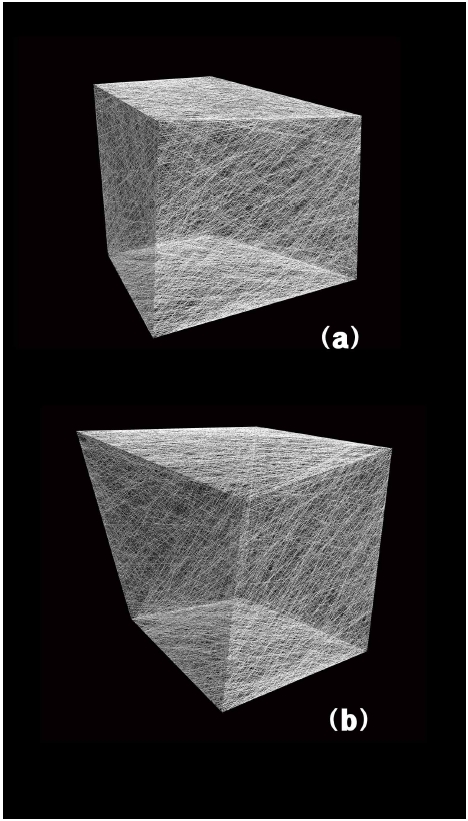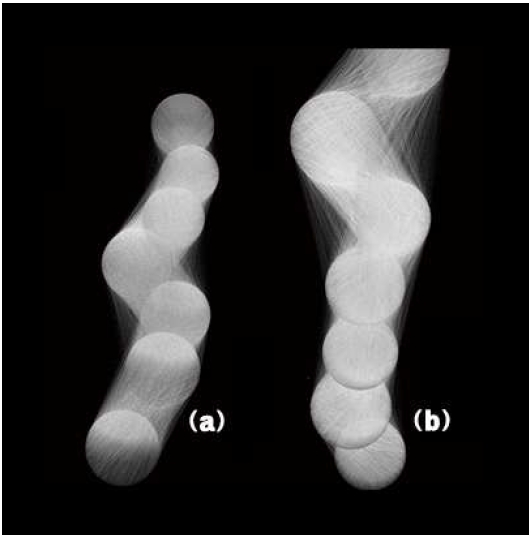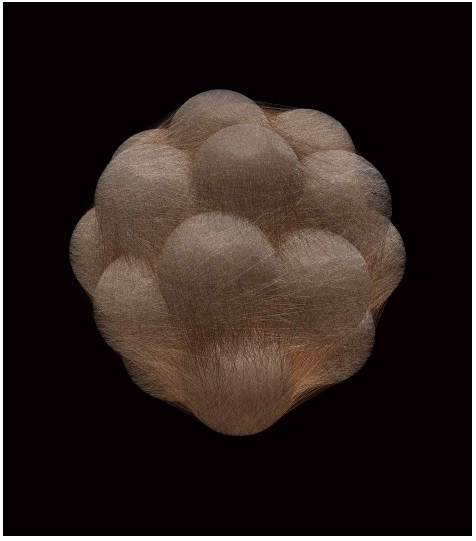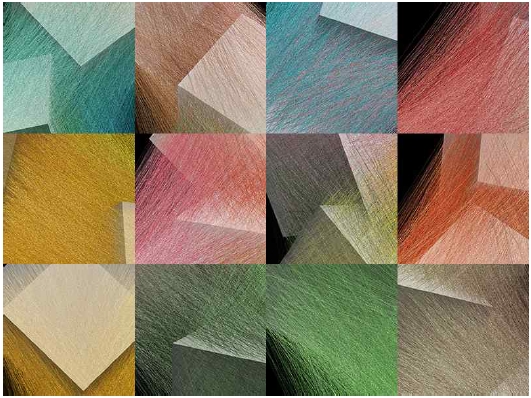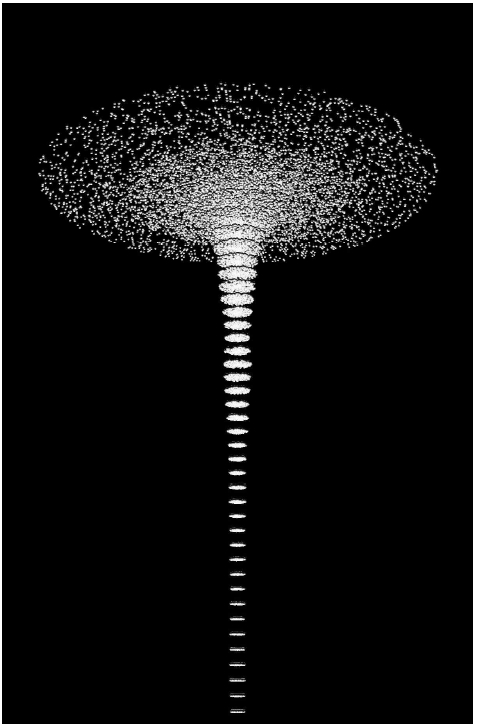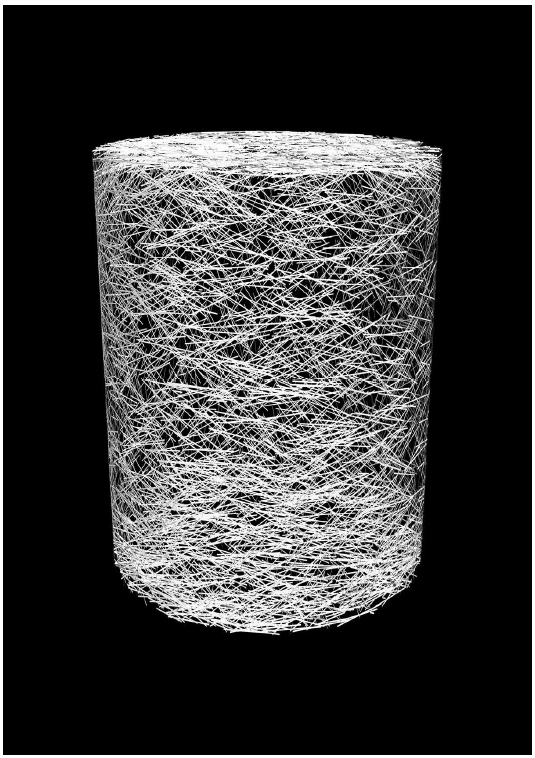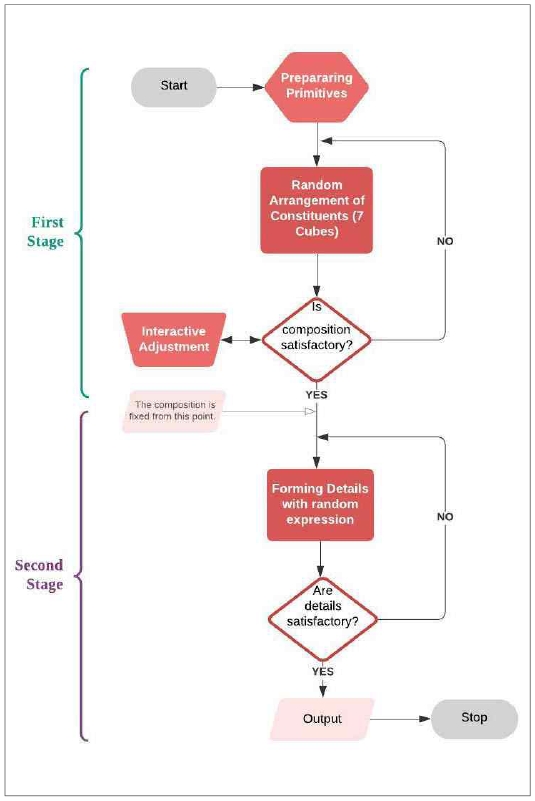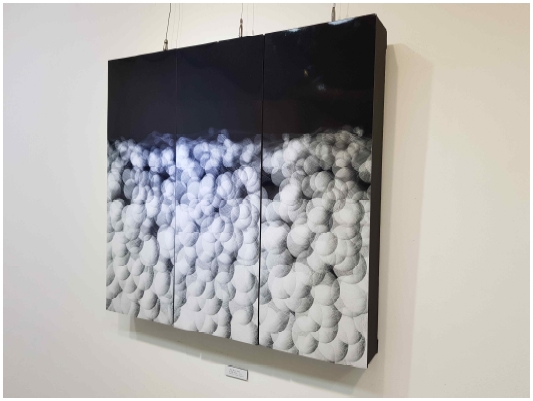
Random-Oriented Morphology in Generative Art: Virtual Sculptures Formed and Composed Using Random Factors
Copyright ⓒ 2024 The Digital Contents Society
This is an Open Access article distributed under the terms of the Creative Commons Attribution Non-CommercialLicense(http://creativecommons.org/licenses/by-nc/3.0/) which permits unrestricted non-commercial use, distribution, and reproduction in any medium, provided the original work is properly cited.

Abstract
Random expressions are crucial in author’s algorithmic artwork composition. The author seeks beauty in a form that harmonizes perceptibility with randomness. In this study, a method of using random expression is introduced within a limited range of intention in forming and arranging visual elements during the production of virtual sculptures. This study also explains how these two elements can be interrelated and strengthen each other in a form in which intentional and random expressions are merged. Randomness has always been author’s major concern in the process of producing artworks and is incorporated from the initial stages of inspiration. Efforts are made to compose visually reinforced morphology by actively utilizing random factors within a controlled range.
초록
무작위 표현은 저자의 알고리즘 기반 아트워크 창작에서 중추적인 역할을 한다. 저자는 인지 가능성과 무작위성이 적절하게 조화되는 형태에서 아름다움을 찾으려고 노력한다. 본 논문에서는 가상 조각 작품 제작 중 의도적이고 무작위적인 표현이 결합된 형태에서 무작위 표현을 의도적인 범위 내에서 사용하는 방법이 소개된다. 이 논문은 또한 이 두 요소가 어떻게 서로 관련되고 강화될 수 있는지에 대해 설명하며, 의도적이고 무작위적인 표현이 통합된 형태에서 어떻게 상호 작용하는지에 대해 다룬다. 무작위성은 항상 저자의 아트워크 창작 과정에서 주요 관심사이며, 영감의 초기 단계에서 의도된 것이다. 무작위 요소를 의도적으로 정의된 범위 내에서 적극적으로 활용하여 시각적으로 강화된 형태를 구성하는 노력이 기울여진다.
Keywords:
Virtual Sculpture, Random Aesthetic, 3D Simulation, Generative Art, Computer Mediated Art키워드:
가상 조각, 무작위 미학, 삼차원 시뮬레이션, 생성 예술, 컴퓨터 예술Ⅰ. Introduction
1-1 Random Expression in Art
The artistic application of randomness has been historically evident, leaving traces in various places, including rock paintings like Cueva de Las Manos dating back around 9,000 years [1]. Art historically, Dadaists represented by Marcel Duchamp and Jean Arp declared chance as a tool of artistic expression and experimented with the possibilities of random expression through their art [2]. In Jackson Pollock's Action Painting, the generated random effects infuse the paintings with vitality and liveliness. Although his actions may appear spontaneous and unconscious, Pollock explains that every aspect was controlled [3]. Font Flurry, designed by Peter Kin-Fan Lo, is an experimental typography drawn randomly with multiple layers in a state of unconsciousness. Compared to traditional typography styles, it appears unpredictable and brimming with vitality [4]. We enjoy using random expressions as forms of style and beauty in our everyday life, ranging from painterly expressions like brushstroke, dripping and overlapping to ink smudging effects seen in Eastern paintings, and even torn jeans.
1-2 Aesthetic Motivation
Not limited to natural occurrences, all the human activities including the creation of artwork also possess random factors. Random technique is widely used in many areas like art, statistics, biological systems, and information security [5]. The accidental outcome is sometimes beyond one’s expectation as shown in Fall (Fig. 1). This work portrays the nostalgia and spirit of a Fall. A circle formed by cylindrical rods under the sphere symbolizing a moon, is transforming to a cubic lattice structure encapsulating the moon. The compositional beauty of cylindrical rods with the random arrangement is the visual highlight of the work that was accidentally generated in the process of transitional animation. After this incident, the randomness has always been the focus in author’s artwork production and intended to be employed from the initial step of the work.
1-3 Propose of Study
Several decades ago, Fred L. Whipple introduced the probabilistic approach to painting and his thoughts in his paper as follows [6]. "Stochastic paintings are those in which shapes and/or colors are structured randomly. A stochastic painting must be based on a set of rules governing the nature of the randomness. Thus, stochastic painting does involve creativity and self-expression. Stochastic painting can be fun because the outcome of a specific set of rules is so unpredictable."
In recent article, L. Alvarez et al. presented research on Aesthetic Abstract Textures (AAT) as a platform for artists and designers to generate new images without the need for programming skills [7]. AAT allows users to interact with parameters to reproduce the forms and composition principles used in abstract painting or experiment with random combinations based on shape, composition, and rendering rules, enabling the creation of artworks in new styles. And random elements are utilized within a complex structure composed of multiple layers in the tree hierarchy, allowing for interactions with other elements.
In this study, random elements are more decisively and directly involved in the process of image formation. In the case of AAT, random is applied to images and form motif selected by a user and random factors modify and transform form and image secondarily. On the other hand, in this study, the user directly forms the shape or image by utilizing random elements without referencing any other visual elements. Although the random effect is not expressed in relation to visual elements from external sources, it is designed to interact with internally defined geometric forms and concepts.
Fred L. Whipple introduced an approach similar to this study in his 1968 paper [6]. As seen in his work 'Clarissa (1966), Stochastic Painting,' random elements are combined with the sequential execution of image formation rules, allowing randomness to be directly and primarily involved in the formation of shapes.
In the oil painting "Untitled (2010)," created through the collaboration of Harold Cohen and AARON, random elements also play a primary and direct role in shaping forms and images. AARON is an Artificial Intelligence program created by Harold Cohen (1928–2016), and according to Louise Sundararajan in her recent paper [8], Cohen regarded AARON as a collaborator, communicating with it throughout the creative process.
These two examples are similar to this study in that random elements are directly and primarily involved in forming shapes and images. However, in these two cases, a single action with randomness is implemented physically in a way that makes the physical modification of the image impossible. In contrast, in this study, the image is implemented by iteratively performing random variations interactively, allowing for computer-processed modifications and adjustments to the image, unlike the two previous examples. In other words, this study aims to derive the best result (within a limited range) that is randomly created by repeatedly executing commands with random variations (within a certain range). And in this research, the artist's utilization of computer language, including probabilistic, repetitive, and interactive technique, to create own artworks is introduced. Through this, a methodology emphasizing the artist's closer and customized involvement in the creative process of generative art is proposed.
Ⅱ. Methodology
2-1 Creation Principle
In author’s artistic viewpoint, 'random aesthetics' is a very essential part. Things created by chance can be more harmonious than intentionally created ones. In the creative process, a random approach has a higher potential to provide the foundation for works that surpass the limitations of our conventional thinking. In fact, the essential nature of art is intentional artifacts rather than natural ones, and it can be considered as the deliberate combination of any form and color. On the contrary, the characteristic of randomness is a representation closer to natural phenomena. Therefore the randomness was actively utilized, but it is done within a deliberate and structured framework with limited boundaries. The deliberate selection and composition of patterns and colors, as artificial elements, intertwine with random factors in the process of creating the artwork. Visually reinforced morphology is created by actively utilizing random factors within a purposely defined range.
2-2 Production Principle
In the art making process random variations in form and pattern are considered from the early stages of the process and establish a set of rules. Based on these rules, when the image is sequentially composed, all visual elements are randomized. In addition, the interactive nature of computer processes and the ability for infinite production to contribute to the creative improvement of artworks have been used. The random process created based on a set of rules were repeated to generate numerous outcomes with various details. As Whipple pointed out, author's expression is included in a set of rules for image formation. The visual conception of each individual work includes expression. The creation of the work is developed sequentially, and various decisions, including the range of randomness applied at every step, are part of the process of expression. The application of random expression and the range of its variation are set differently depending on the characteristics and progress stages of each work, serving to enhance its aesthetic aspects. To ensure meticulous adjustments, the step-by-step process is conducted in an interactive manner. All these decisions are intentional processes and methods of expression. The relationship between the aesthetic elements and random expressions of each work is explored in detail in the 'Ⅴ. Case Reviews: Random Oriented Morphology' section. It explains how the unique forms and intention can be strengthened by using the random effect in actual artworks.
Art is in general limited in the sense that each work produces only a singular result. In contrast, algorithmic art utilizing the random allows the reproduction of different outcomes from a singular source. Each artwork has one objective flow of algorithm, though. If it is randomized, it’s each execution induces one and only result out of infinitely possible outcomes. In other word, each flow of an work can produce infinite number of results with different details. Therefore, each image presented in this paper corresponds to one of the possible outcomes produced from the coding of an work.
Knut Reinert, Types of algorithms, writes,
One important distinction one can make is, whether the algorithm is deterministic or randomized. Deterministic algorithms produce on a given input the same results following the same computation steps. Randomized algorithms throw coins during execution. Hence either the order of execution or the result of the algorithm might be different for each run on the same input [9].
Pseudo random numbers refer to the values created by algorithms to mimic random numbers, when the algorithm that produces pseudo random numbers is called a pseudo random number generator (PRNG) [5]. A computer system supports the generation of pseudo random numbers by a system function, usually named Rand(). Due to the limitation of a computer system, it cannot support absolute random number. The pseudo random number is created by an algorithm based on the seed number and it ultimately has a pattern due to the initial conditional limit. Computer generated pseudo random numbers are used for random expression in the creation of algorithmic artworks. According to the choice, the random function can take charge of decisions regarding the expression. Pseudo random numbers can be used for maneuvering, manipulating, and selecting in the creation process. Applying the methodology of random can be varied according to the application, planning, and customized algorithm.
Ⅲ. Composition
3-1 Randomized Forms
Random factors promote deformation to various three dimensional forms. Arbitrary expressions are essential elements in constructing basic geometric objects such as cubes, spheres, cylinders, and pyramids of author’s artwork. Thus the random factor is considered from the beginning stage of the creating process. For example, two objects of (a) and (b) in Fig. 2 have different 3D-forms and details, even though they are generated from the identical algorithm. The 3D-form of hexahedron itself are determined by arranging the imaginary position of 8 vertexes of a hexahedron in random within an observable range. The details are settled by arranging position, length, and thickness of lines (looks like lines, though, but actually they are thin polygons) randomly on 6 imaginary planes of a hexahedron.
3-2 Randomized Composition
The random function is used to assemble the whole composition of algorithmic artwork. The majority of author’s works are produced by imagining the configuration of abstract images based upon simple geometric forms such as spheres, cubes, and cylinders. Therefore, they are not depicted but rather configured to upper-level forms using essential lower-level constituents [10]. In this configuration process, the random manipulations are involved. In Fig.3 the positions of spheres are maneuvered by random numbers to get an unexpected composition. In this piece the composition of entire work is defined by the positions and the sizes of seven spheres. In each execution the spheres will be moved to random positions within an intended range. As a result, it shows the two different version of compositions of (a) and (b) in Fig. 3 according to random variation that are generated from the identical algorithm. Fig. 3 where the composition of artwork is determined in real time using random factors can be contrasted to Fig. 4 where the overall specific composition is fixed in advance and only details are produced in real time.
Ⅳ. Color
In painting, besides the mental elements related to artist and viewer, there exist physical elements related to expressing colors: particles of pigments made of various colors, the texture of canvas, thickness of the coated paints, expressive brush strokes, the area and surrounding color, and even white background of canvas itself that are not painted. In comparison, the RGB color expression on the computer system is relatively monotonous and shallow due to the absence of such complex physical elements. Random presentation can be a tool to enhance the computer color expression. Artist could acquire unexpected and plenteous outcomes by defining number in color expression of algorithmic art as random numbers than we could obtain from the fixed one. Followings are the methods that author usually use to apply the randomized color to objects in the creation process [11],[12].
4-1 Randomized RGB Color Expression
In computer system, the color is expressed as RGB tripet (r, g, b) and each component value is an integer in the range of 0 to 255 that 8-bit byte can offer. Instead of fixed numbers, the random numbers are combined in the RGB numbers. In specific, each number of R, G, and B components is limited to a narrow range for specialized color formulation rather than full range of 0 to 255. After randomly picking the number within the limitation, we use the randomized R, G, and B numbers as a combination of RGB color in the repetition process of algorithm. The example of compact description is shown as below.
| (1) |
4-2 Randomized Mapping
In the case of thousands of small components gathered to form an object as a whole, author applies an image map randomly picked among many to each component instead of a fixed map in the repeat process. In recent works the maps are randomly assigned to thousands of thin polygons and the partially cropped resultant images are shown in Fig. 5.
Ⅴ. Case Reviews: Random Oriented Morphology
In this section the random usage in actual cases of individual algorithmic artworks is reviewed from the whole process of creation point of view. This is reviews of author’s artwork to demonstrate how random expressions are used to enhance the concept and the forms of each original works.
5-1 Population Explosion, 2009
The change in human population throughout history is simulated as a virtual sculpture, shown in Population Explosion (Fig. 6). The work is produced by employing the historical human population data of International Data Base (IDB) from BC to the present. The IDB was developed by the U.S. Census Bureau to provide demographic information around the world needed for research, program planning, and policy-making decisions, in the U.S. and globally [13]. The provided data utilize historical estimates of population. The change is mainly due to the explosive quantitative increase in the population, and thus the virtual sculpture shows the accelerative tendency as approaching to the present. Visual effects were sophisticated and emphasized by random factors. Spheres, denoting a million people, are randomly spread within the invisible circular planes (disks) that are chronologically separated. The overall shape of this sculpture is coordinated by the intervals between virtual disks and their sizes. The number of spheres is directly proportional to the population data, while the size of disk was modulated to provide the aesthetic to the whole figure and to emphasize the feeling of ‘explosion.’ The spheres are randomly placed on invisible disks, and as a result, the visual effects are meticulously rendered by random elements to evoke the feeling of a starry night sky [14].
5-2 Cylinder, 2015
The three-dimensional geometric shape, cylinder, which everyone knows, became more special using a random factor. This common structure is reinforced by random morphology as shown in Cylinder (Fig. 7). Randomly scattered numberless thin polygons reflecting natural objects like bushes or grasses floating on water are building a formal form, a cylinder. The three-dimensional sense is expressed solely by random arrangement of a number of thin polygon meshes at the invisible cylindrical surface. Random, a naturally occurring factor, is combined with a formal geometric artificial feature. The length, thickness, and position of a polygon are modulated into many variations using a random function within the intended range. The numberless objects are irregularly aggregated, but at the same time precisely arranged at the surface of a regular cylinder. The randomly arranged elements that construct a porous cylinder are reinforcing the cohesion of an object, cylinder. This is identical to that an irregularly tangled skein appears to be more cohesive than a regularly wound lump of thread. Also, distinctively dissimilar details are produced at each execution and the random expression represents the main visual characteristic of this artwork.
5-3 Rainbow #1, 2020
The interactive creation methods were applied to the production of artwork as shown in Rainbow #1 (Fig. 8). At the first stage the composition was examined by the progressive build-up solution. First, seven cubes are piled up from bottom to top with some regulations. However, in this procedure, the composition is settled with considerable random variations of size, position, ratio, and orientation of cubes. This process was repeated until a satisfactory result comes out. If a result seems meaningful or if it inspires something and looks aesthetic, then usually stops there and adjusts the spheres interactively to finalize and fix the composition. In the case of Rainbow #1 it reminds a rainbow. At the second stage, thousands of lines (thin polygons) were connected from the surface of the nth cube (from the bottom) to the surface of (n+1)th and (n+2)th cubes. Although starting and finishing points of the lines are limited to the surface of cubes, the positions are random within it, suggesting the contrast of regularity and irregularity. Random threads of a cobweb make the composition dense, unify the objectivity, and show different details. The overall color tone (rainbow pastel tone in Rainbow #1) and the color variation patterns are determined in advance. The image maps that will be applied to the meshes themselves already have thematically varied colors in their pixels. Also, because the map that is randomly picked among the several ones instead of a fixed one is applied to each thin mesh, a different hue of color is generated at each execution, providing the audience a slightly different impression of each piece. The work flow of Rainbow #1 is presented in Fig. 9.
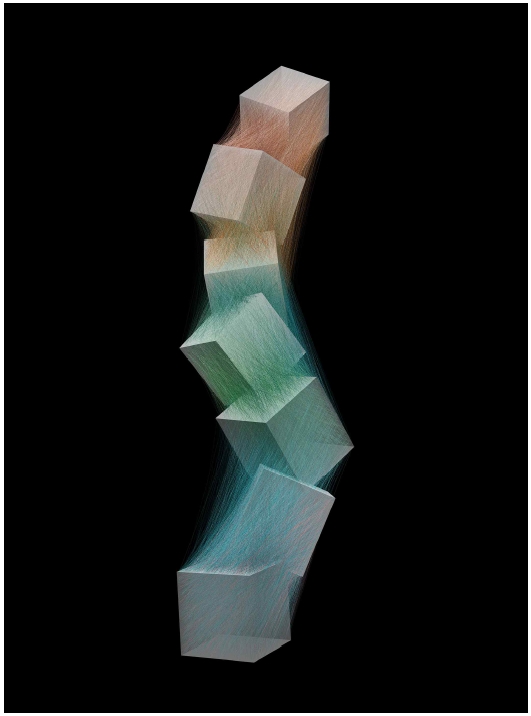
Jin-Hee Kim, Rainbow #1, Virtual Sculpture, 2020. The numberless lines, randomly connecting cubes, are reinforcing overall morphology.
Ⅵ. Conclusion
Jackson Pollok’s ‘action painting,’ where pigment finds its way on the canvas through improvisational actions such as dripping, creates random details that still takes into consideration of the overall harmony of the composition [15]. Vainness that is the lack of texture and substance is the dilemma of digital art. Compared to paintings presented by countless chemical particles of pigments, the RGB color expression of computer art seems shallow. However, the generative system provides a different environment of expression from different dimensions. Among them the random technique combined with process methodology endows the possibility of new expression in composition, form, details, and color of an artwork. The creation of author’s artwork is proceeded by forming the close relationship with the technical environment of the generative system [16], [17]. Technology as a tool of artwork creation expands and reinforces ability of expressing space and time [18]. In conclusion, this study is an attempt to more actively apply the concept of randomness in the creative process of virtual sculptures with geometric compositions, and it can be summarized as follows. First, it showcases examples of creative attempts that consider random variations in the process of creating three-dimensional virtual sculptures. Second, it demonstrates examples of pursuing diversity in forms and generating unexpected outcomes by utilizing randomness in the implementation of geometric 3D shapes. Third, it proposes a methodology for attempting diverse and aesthetic compositions by utilizing randomness when combining geometric solids into a single structure. Fourth, it demonstrates techniques for implementing the colors of virtual sculptures by utilizing randomness. Fifth, it illustrates how the range and method of applying randomness vary for each work according to its unique characteristics, thereby enhancing the concept of the artwork through random expressions. The ultimate aim of this study is to propose a methodology for utilizing computer processes in the creation of virtual sculptures. The presented works have been introduced to the public (Fig. 10) through three solo exhibitions [19]-[21]. The creative methodologies presented in this paper as a possibility for future academic generations and the art creation community.
People enjoy finding a recognizable form in the cloud and I always do. I admire finding a Greek God of hairy face in the cloud. My mental drawn into the utopia of clouds and my eyes take a journey into columns in cloud. Their form is loose and careless, and thus there is a lot of room for imagination. The concept is alive in our mind and we interpret it freely. The 3-dimensional space always inspires me. I create systematic artifacts of conformable nature in a space with the configuration of intention and random factors. I hope the audience find something imaginable in a pictorial space of my work just like they do in the nature⋯ by Author
References
- UNESCO, World Heritage Sites: A Complete Guide to 1007 UNESCO Worked Heritage Sites, 6th ed. Richmond Hill, Canada: Firefly Books, 2015.
- J. Arp, Arp on Arp: Poems, Essays, Memories, New York, NY: Viking Press, 1972.
-
M. H. Dominiczak, “Emotions: From Jackson Pollock to Contemporary Science,” Clinical Chemistry, Vol. 62, No. 6, pp. 903-904, June 2016.
[https://doi.org/10.1373/clinchem.2015.253096]

- K. Ziegler and N. Greco, The Designer’s Guide to Web Type: Your Connection to the Best Fonts Online, New York, NY: Harper, 2001.
-
Z. Liu, M. Huang, and S. Zhu, “Design and Implementation of A Pseudo Random Number Generation,” in Proceedings of 2009 International Conference on Computational Intelligence and Natural Computing, Wuhan, China, pp. 126-129, June 2019.
[https://doi.org/10.1109/CINC.2009.242]

- F. L. Whipple, “Stochastic Painting,” Leonardo, Vol. 1, No. 1, pp. 81-83, January 1968.
-
L. Alvarez, N. Monzón, and J.-M. Morel, “Interactive Design of Random Aesthetic Abstract Textures by Composition Principles,” Leonardo, Vol. 54, No. 2, pp. 179-184, April 2021.
[https://doi.org/10.1162/leon_a_01768]

-
L. Sundararajan, “Harold Cohen and AARON: Collaborations in the Last Six Years (2010-2016) of a Creative Life,” Leonardo, Vol. 54, No. 4, pp. 412-417, August 2021.
[https://doi.org/10.1162/leon_a_01906]

- A. Bockmayr and K. Reinert, Concept: Types of Algorithms, Freie Universität Berlin, Berlin, Germany, Discrete Math for Bioinformatics WS 10/11, pp. 1001-1011, October 2010.
- J. H. Kim, “Computer Graphic Art Working Focused on Structural Composition,” Journal of Digital Design, Vol. 14, No. 4, pp. 833-842, October 2014.
-
L. W. MacDonald, “Using Color Effectively in Computer Graphics,” IEEE Computer Graphics and Applications, Vol. 19, No. 4, pp. 20-35, July-August 1999.
[https://doi.org/10.1109/38.773961]

-
M. C. Stone, “Representing Colors as Three Numbers,” IEEE Computer Graphics and Applications, Vol. 25, No. 4, pp. 78-85, July-August 2005.
[https://doi.org/10.1109/MCG.2005.84]

- U.S. Census Bureau. International Database (IDB) [Internet]. Available: http://www.census.gov/programs-surveys/international-programs/about/idb.html, .
-
J. Kim, “3-Dimensional Virtual Visualization of Historical Population Change,” Journal of Digital Design, Vol. 10, No. 3, pp. 277-285, July 2010.
[https://doi.org/10.17280/jdd.2010.10.3.028]

-
B. Palacios, A. Rosario, M. M. Wilhelmus, S. Zetina, and R. Zenit, “Pollock Avoided Hydrodynamic Instabilities to Paint with His Dripping Technique,” PLoS ONE, Vol. 14, No. 10, e0223706, October 2019.
[https://doi.org/10.1371/journal.pone.0223706]

-
F. Nake, “Algorithmic Art,” Leonardo, Vol. 47, No. 2, p. 108, April 2014.
[https://doi.org/10.1162/LEON_a_00706]

-
V. Ceric, “Algorithmic Art: Technology, Mathematics and Art,” in Proceedings of the 30th International Conference on Information Technology Interfaces (ITI 2008), Cavtat, Croatia, pp. 75-82, June 2008.
[https://doi.org/10.1109/ITI.2008.4588386]

-
S. L. Sheridan, “Generative Systems versus Copy Art: A Clarification of Terms and Ideas,” Leonardo, Vol. 16, No. 2, pp. 103-108, 1983.
[https://doi.org/10.2307/1574794]

- J. H. Kim, Solid & Space, Cheongju Art Center, Cheongju, February-March 2019.
- J. H. Kim, Compositions, Cheongju Art Center, Cheongju, May 2019.
- J. H. Kim, Movement in a Moment, Cheongju Art Center, Cheongju, May 2020.
저자소개
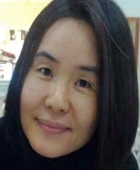
1994년:University of Wisconsin-Madison (BS with a major in Art)
1995년:University of Wisconsin-Madison (MFA with a major in Computer Mediated Art)
1988년~1989년: 한국과학기술원 시스템 공학센터 연구원
1995년~현 재: 백제예술대학교 교수
※관심분야:생성예술(Generative Art), 컴퓨터 아트(Computer Mediated Art), 가상현실(VR) 등

